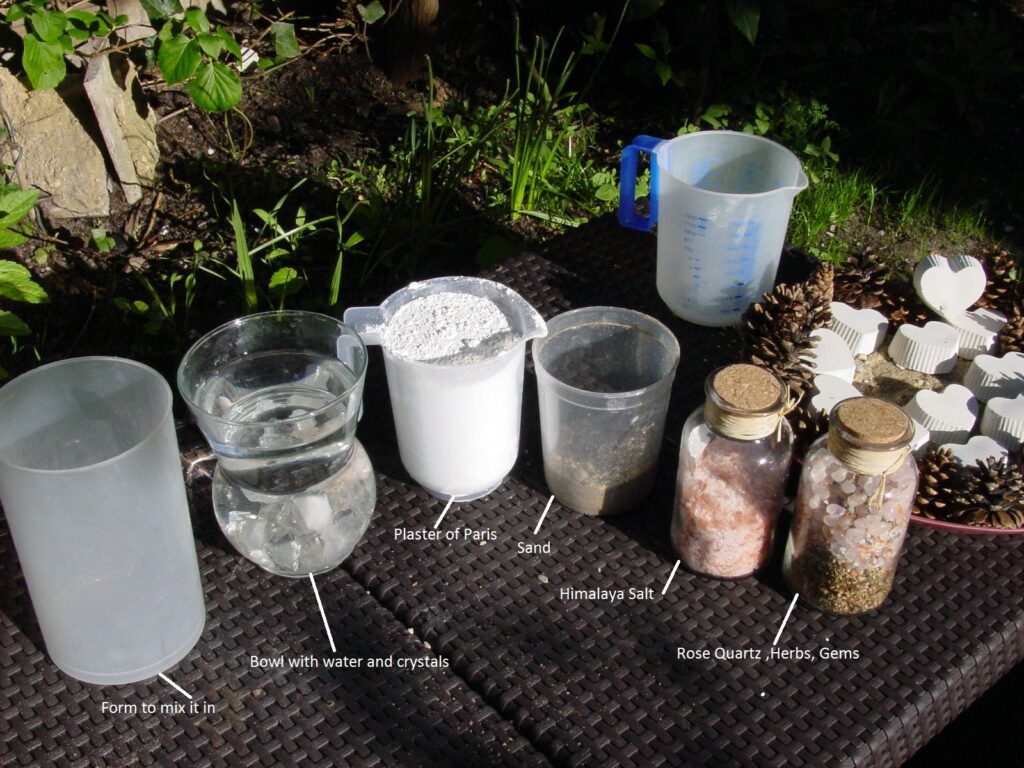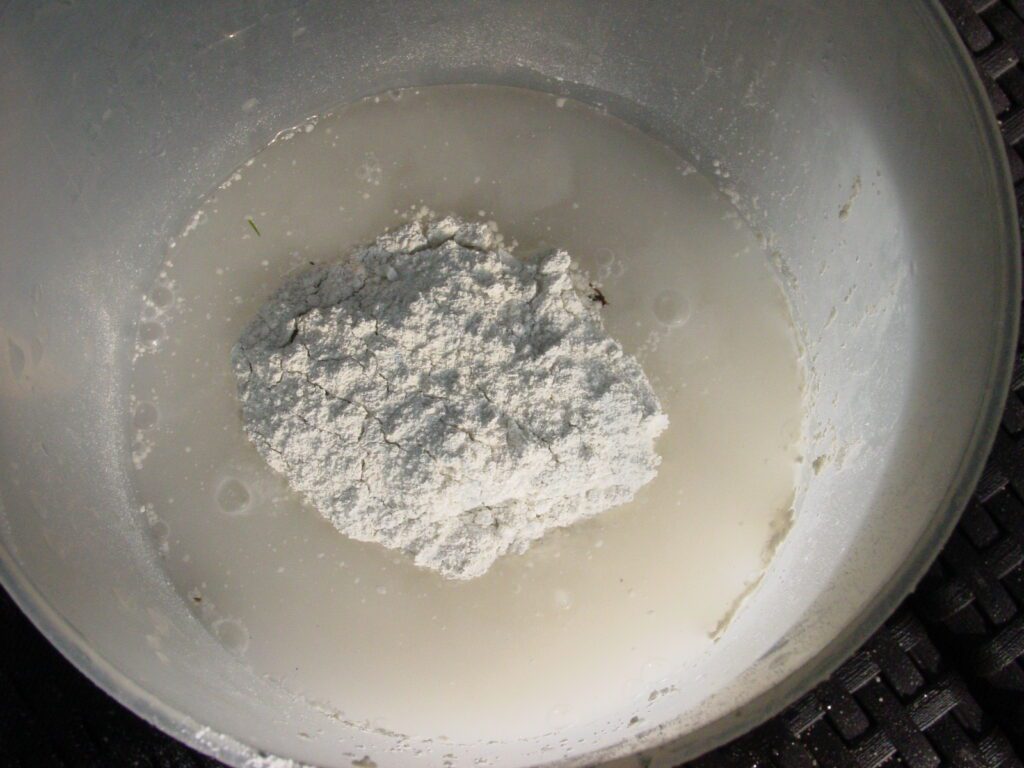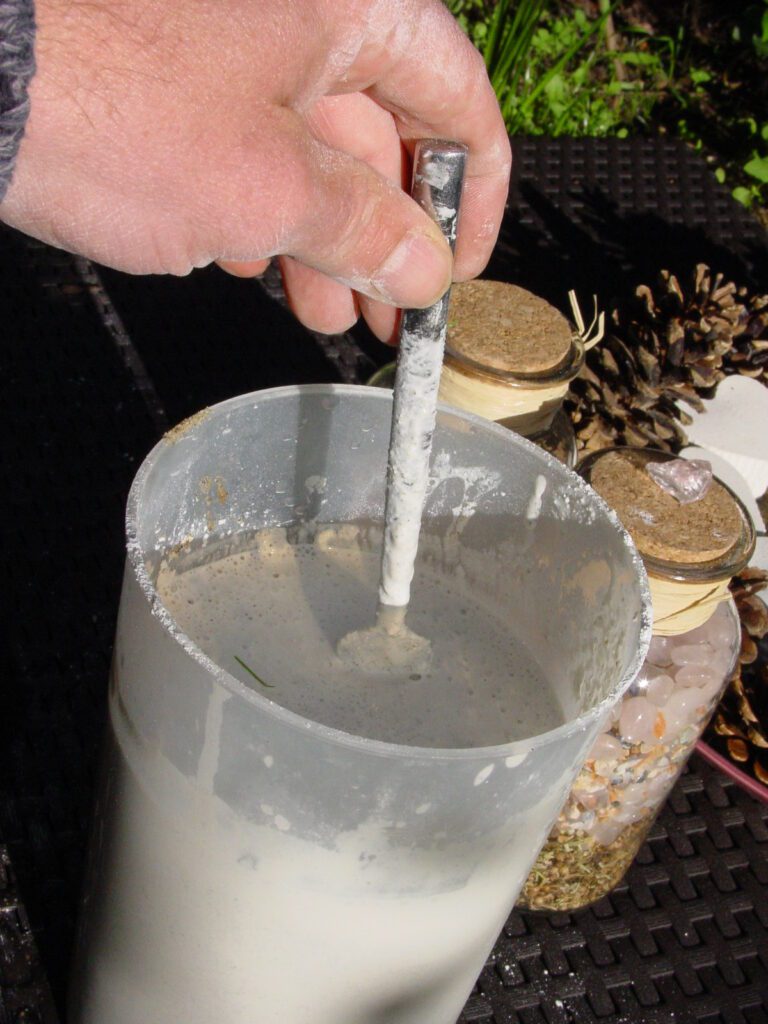
One needs :
Plaster of Paris , sand, natural salt and that is basically it.
Start with water in a bucket add some natural salt than mix the plaster of Paris in and add the sand.
Ratio Plaster to water is usually one on one, maybe a bit more water than plaster as you mix the sand in
The whole thing should be done in a moment of focus and intention of Healing.
That is the main aspect, best not to overthink it , just do it and it will work.
Might be interesting for some of you to see it happen in a more graphical form, a visual guide.





Note : I said NATURAL salt, meaning not kitchen salt.… just saying…just saying….any natural salt will do , Himalaya salt I use often but as we all go broke you can use Celtic Salt or what I use now, basic Atlantic salt, sea salt, it is cheap enough.







The water one uses , it is best to put crystals or stones in a vase and use that water , infused. It is not essential but it helps. Also you do not have to use the physical rock crystals, just use the water that is good enough.

This is good sand, good mixed sand, this is excellent.

About 20 % sand , more or less…gosh maybe it is 22.36 %….darn …

Now you mix the whole thing up…..it will start hardening…takes a while but you will feel it gets thicker, slower, like yogurt…


Again, this is optional, you can also use some sea shells…like that one here, with a resonant chamber, or any other natural harmonic form, acorns, pine cones…
I usually stick with sea shells if I use it, which is seldom.


Main thing is to put your desires in the tool of Light , THAT is important….essential really…
Did I say essential ? Essential it is. As that is the part that is often overlooked or ignored , well you will notice that in the results, not so good.
Good intent is good result.
Love in Love out..


Mostly I use tiny crystal powder, not big rock crystals but….again…the sky is the limit or even beyond…
In this case rose quartz….


Healing Completed. You will have a blue sky without the …you know what…that is going on.
Another word for Plaster of Paris is gypsum, which is a form of Selenite, also goes under the name

Gypsum is a soft sulfate mineral composed of calcium sulfate dihydrate, with the chemical formula CaSO4·2H2O. It is widely mined and is used as a fertilizer and as the main constituent in many forms of plaster, drywall and blackboard or sidewalk chalk.
Gypsum also crystallizes as translucent crystals of selenite.
It forms as an evaporite mineral and as a hydration product of anhydrite. The Mohs scale of mineral hardness defines gypsum as hardness value 2 based on scratch hardness comparison.
Fine-grained white or lightly tinted forms of gypsum known as alabaster have been used for sculpture by many cultures including Ancient Egypt, Mesopotamia, Ancient Rome, the Byzantine Empire, and the Nottingham alabasters of Medieval England.
Etymology and history
The word gypsum is derived from the Greek word γύψος (gypsos), “plaster”. Because the quarries of the Montmartre district of Paris have long furnished burnt gypsum (calcined gypsum) used for various purposes, this dehydrated gypsum became known as plaster of Paris. Upon adding water, after a few dozen minutes, plaster of Paris becomes regular gypsum (dihydrate) again, causing the material to harden or “set” in ways that are useful for casting and construction.
Gypsum was known in Old English as spærstān, “spear stone”, referring to its crystalline projections. Thus, the word spar in mineralogy, by comparison to gypsum, refers to any non-ore mineral or crystal that forms in spearlike projections. In the mid-18th century, the German clergyman and agriculturalist Johann Friderich Mayer investigated and publicized gypsum’s use as a fertilizer.
Gypsum may act as a source of sulfur for plant growth, and in the early 19th century, it was regarded as an almost miraculous fertilizer. American farmers were so anxious to acquire it that a lively smuggling trade with Nova Scotia evolved, resulting in the so-called “Plaster War” of 1820.
Physical properties
Gypsum crystals are soft enough to bend under pressure of the hand. Sample on display at Musée cantonal de géologie de Lausanne.
Gypsum is moderately water-soluble (~2.0–2.5 g/L at 25 °C)[13] and, in contrast to most other salts, it exhibits retrograde solubility, becoming less soluble at higher temperatures. When gypsum is heated in air it loses water and converts first to calcium sulfate hemihydrate (bassanite, often simply called “plaster”) and, if heated further, to anhydrous calcium sulfate (anhydrite). As with anhydrite, the solubility of gypsum in saline solutions and in brines is also strongly dependent on sodium chloride (common table salt) concentration.[13]
The structure of gypsum consists of layers of calcium (Ca2+) and sulfate (SO2−4) ions tightly bound together. These layers are bonded by sheets of anion water molecules via weaker hydrogen bonding, which gives the crystal perfect cleavage along the sheets (in the {010} plane).
Crystal varieties
Main article: Selenite (mineral)
Gypsum occurs in nature as flattened and often twinned crystals, and transparent, cleavable masses called selenite. Selenite contains no significant selenium; rather, both substances were named for the ancient Greek word for the Moon. ( Selene)
Selenite may also occur in a silky, fibrous form, in which case it is commonly called “satin spar”. Finally, it may also be granular or quite compact. In hand-sized samples, it can be anywhere from transparent to opaque. A very fine-grained white or lightly tinted variety of gypsum, called alabaster, is prized for ornamental work of various sorts. In arid areas, gypsum can occur in a flower-like form, typically opaque, with embedded sand grains called desert rose. It also forms some of the largest crystals found in nature, up to 12 m (39 ft) long, in the form of selenite.
What is Plasterite?
Plasterite is a tool to protect you and your family from the harmful energy emitted by computers, TVs, cell phones, cell phone towers, wifi, smart meters, etc. It pulls in and transforms these frequencies into a different form of energy (also known as chi, or life force energy) that is very beneficial to people, pets, and plants.
Plasterite is a substance made of non-toxic ingredients: plaster of Paris, sand, crystals, Himalayan salt, and crystal-infused water. I also include essential oils, zeolite, bentonite clay, spirulina, azomite, and powdered kelp. These extra ingredients are chosen for their healing and cleansing properties. After everything is mixed together, I pour it into molds where it hardens rapidly and forms a crystalline structure.
Benefits of plasterite:
The effects of plasterite differ from person to person. Commonly reported effects are:
• Better sleep and vivid dreams; frequently remedies insomnia and chronic nightmares
• Balanced, happier moods; relief from depression and anxiety
• Promotes plant growth
• Cleans stagnant and negative energy
• Deepens meditation
• Strengthens intentions and visualizations
• Brings joy to children
Frequently Asked Questions
Q. Where should I put my plasterite pieces?
A. Near any electronic device: by your computer, near your cell phone (especially if you leave it by your bed at night), near your wifi, in your car (to protect you both from the electronic systems of your car and the many cell phone towers you drive by), in your fridge (you may find that your food stays fresh longer), and on your nightstand.
Q. Is it OK to paint plasterite? What do you paint it with?
A. My energy-sensitive friends report that paint modifies the energy of plasterite. It still works, but it is more subdued. Painted pieces are still beneficial and functional! I paint my pieces either with nontoxic acrylic paint or watercolor. Plasterite makes a wonderful 3-D canvas for watercolor paints!
Q. How do you know that plasterite works?
A. Though invisible to us, there is an energetic cleansing and exchange that takes place in plasterite. Much like a box of baking soda pulls out and neutralizes odors in a refrigerator, plasterite pulls in and neutralizes harmful energy from electronics. There are unfortunately no scientific tools that measure life force energy! This is an energy that is better understood from a quantum physics perspective, a discipline which is still unfolding to the world. Instead, we rely on testimonials and reports from people who are sensitive to the energy of crystals. They describe the energy of plasterite as a cool, smooth, calming feeling that spreads slowly through their body. Plasterite is a reconstituted crystal; it has crystalline energy in a matrix similar to quartz (which is used in computer chips, radios, and more). Plasterite is made out of many different gemstones, minerals, and millions of gypsum crystals that are created as the plaster sets (plaster of Paris is a powdered gypsum, a form of the gemstone selenite). Plasterite contains trillions of tiny cavities (formed when the water in its matrix evaporates), and energy resonates in each cavity.
Q. Will plasterite ever wear out or become filled up with negative energy from electronics?
A. No. It is self-cleansing and will continue to function forever. There is sand in plasterite, which is mainly composed of quartz (which is also self-cleansing); this is why it doesn’t need cleansing the way some crystals do.
About the Artist
I am a former Special Education teacher, currently staying at home full-time to raise my two daughters with my husband in Fresno, CA. I have explored many avenues related to health, healing and spirituality, including Reiki, homeopathy, essential oils, and nutrition. My other passions include nature, gardening, music, cooking healthy meals for my family, and reading. Creating plasterite brings me a lot of joy, and I am happy to be able to share my products with you and your family.
Made by June Carnahan in Fresno, CA
PROTECTION CANOPY MAKING – NEUTRALIZING GEO-ENGINEERING
Me again.
It is not ” just” to overcome, neutralize the effects of the geo-engineering, it is a much bigger picture. It is a lot bigger than just that.
That is the first layer of an onion and it is a big onion.

